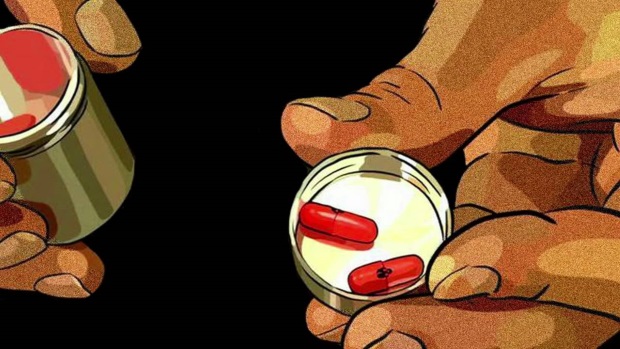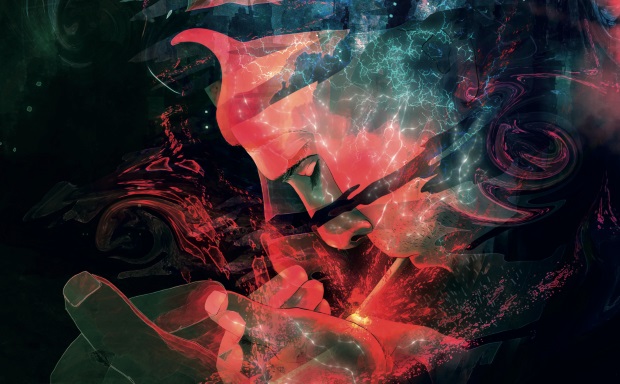Addictions and drugs in science fiction storytelling
Aliya Whiteley rounds off her guest series exploring the darker edges of addiction in science fiction...
In 1974 the author Robert Silverberg was asked by the National Institute on Drug Abuse to prepare a report on how drugs are portrayed in science fiction. In the report – available to read online here – he compiled a hugely detailed list that broke down sci fi drug use into nine categories by what effect the drugs had: euphorics, mind-expanders, and sensation enhancers, for example. If you’re looking for pre-1970s science fiction to read on this topic, then Silverberg’s list is the place to go to.
Have things changed since then? I think his definitions still apply, but perhaps the form that the drugs are presented in can be said to have changed to fit modern preoccupations more precisely. There’s also the use of drugs as a device to ground us in a setting that might otherwise be confusing, much like the use of alcohol – possibly because nowadays there’s a more widespread societal awareness of drug issues. China Mieville creates a street drug called ‘feld’ early on in The City And The City (2009) to give us a flavour of the world we’re reading about, but he also outlines how the name has several meanings – “Its name is a trilingual pun: it’s khat where it’s grown, and the animal called ‘cat’ in English is feld in our language. I sniffed it and it was pretty low-grade stuff.” A dual meaning for a drug in a dual city makes perfect sense.
The worse the world, the more we can understand why the inhabitants might turn to the escape of narcotics; in Harry Harrison’s Make Room! Make Room! (1966) the population crisis means that people live in terrible, overcrowded conditions. The only escape for many of them is either euthanasia or LSD; it’s an easy path to private space inside your own head.

But these paths out of reality are never without their own consequences; Philip K Dick’s own experiences with drugs led directly to the writing of A Scanner Darkly (1977), in which the highly addictive Substance D confuses everything, turning the detective into the addict, and the known into the unknown. There’s a great 2006 animated film version of the book that blurs representations of reality and fantasy in very interesting ways onscreen.
What if it’s not a pill or a substance that can hook you, in a dystopian future, but a technological development? Television, computers, virtual reality: science fiction writers have taken inspiration from invention, suggesting that these new forms of escape might also become addictive. In Strange Days (1995) ex-cop Lenny Nero has become a seller of SQUID recordings. These tapes allow the user to directly experience the emotions and events of another; it’s not unlike a form of virtual reality, twinned with the element of escape associated with psychoactive drugs. There’s a black market trade in the worst kind of experiences. People become addicted to violent imagery, and don’t care who suffers in their desire to get it.
Along a similar vein but also in a body-horror-heavy world entirely of its own is David Cronenberg’s Videodrome (1983), where the technological and the biological mingle (see also Existenz, his 1999 film) to produce nightmarish addiction to cheap, violent television. Ryan Lambie has already written brilliantly on this site all about why Videodrome is seriously noir, so I’ll leave the description up to him.
But perhaps the most elegant of all the noir science-fiction crossovers are those that use an element of noir as the addiction itself. We associate noir with the darkness – the detective often moves under the cover of night, and the villains lurk in the shadows. What if light itself was the drug that everyone craves? Oliver Langmead’s epic poem Dark Star (2015) is set on a planet that orbits a sun emitting no light, and addiction to a drug called Prometheus is common; it envelops the user in much-craved warmth, like sunshine, but this can easily prove fatal. Light and dark, black and white: these are opposites that suit the big moral questions we find in so many stories, including crime and epic poetry – in Dark Star these genres create a surprisingly cohesive story.

Let’s finish up with Jeff Noon. Writing novels that thrive by tying noir to science fiction to the downright weird, Noon’s Vurt (1993) features coloured feathers that are incredibly powerful drugs, acting as gateways to an alternative reality, and his later novel A Man Of Shadows (2017) uses noir addiction as a reflection on time itself. Detective John Nyquist lives in a world where everybody makes their own personal time, adjusting their watches as they see fit. The drug of choice is Kia, an orange liquid that reveals to the user: what? The future? What they most desire, or fear, to come true? Knowing what happens next is hugely addictive, but destroys the mind. Kia plays with time in a most troubling way, and reminds us that the narrative itself is a construct, placing one event after the other until a meaning is arrived at. A detective story relies upon the promise of an answer to a question; in Noon’s books, sometimes you end up not quite sure what the question was to begin with.
No matter where the future might lead, and what answers might be provided on this planet or another, there are always more detectives being created out there, bringing fresh questions and original takes to our addictions, old and new. Whether in a film or television series, as a comic or a novel, noir continues to inspire. I’ve only touched on a few of the existing examples (see this article by Jeff Noon himself about other imaginary drugs in particular, with varying amounts of noir mixed in if you want more); I wonder what will prove to be addictive in fiction next, and whether it will continue to rely on a hard-boiled detective, a squalid side of the city, and a smoke-filled bar, late at night, where dark deeds aren’t only in our imaginations?
Aliya Whiteley’s latest novel, The Loosening Skin, will be published in October 2018 by Unsung Stories. It’s a noir-tinged science-fiction story of love, addiction, and forgiveness.